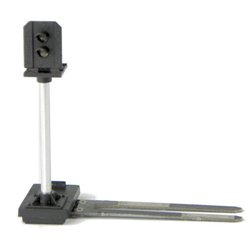There are a number of different options for attaching figures such as a horse and rider to a layout. Perhaps the...
No products
Product successfully added to your shopping cart
There are 0 items in your cart. There is 1 item in your cart.
Search Tips
What is a 4 aspect signal?
In the context of UK railways, a "four-aspect signal" is a type of railway signal that provides four distinct indications to inform train drivers of track conditions and speed requirements ahead. Aspect signals are critical for ensuring safe and efficient train operations, as they help to manage the flow of trains and prevent collisions on shared tracks. Four-aspect signals provide more detailed information than simpler signals with two or three aspects, making them essential on busy lines and where trains operate at high speeds.
The four aspects in these signals are green, double yellow, yellow and red, each with a specific meaning. A green aspect, sometimes referred to as a "clear" signal, indicates that the line ahead is free of obstructions and the driver can proceed at the line speed. The double yellow aspect, which shows two yellow lights, is a warning to the driver that the signal two blocks ahead is red, giving them a preliminary indication to reduce speed. The yellow aspect, which shows a single yellow light, warns the driver that the next signal is red and that they should be prepared to stop. Finally, the red aspect instructs the driver to stop, as the block ahead is occupied or otherwise unsafe.
The additional information provided by a four-aspect signal allows drivers to adjust their speed more gradually, which is particularly beneficial on high-speed lines. By giving a double yellow warning two signals before a red, drivers can begin slowing down in advance rather than making sudden reductions in speed. This not only enhances safety but also improves passenger comfort and fuel efficiency, as smoother braking and acceleration reduce wear on train components and minimise energy usage.
Four-aspect signals are typically used in areas with high-density traffic, where more frequent signals are needed to control the safe separation between trains. These signals are also common on lines with complex track layouts or junctions, where trains may need to follow varied paths and speeds. In such areas, the extra warning provided by the four-aspect system can make a significant difference in preventing bottlenecks and allowing trains to run closer together without compromising safety.
In practical terms, four-aspect signals are part of a block signalling system, which divides the railway line into sections or "blocks." Only one train is allowed in each block at a time, ensuring that each train has a safe distance from the train in front. The four-aspect signals communicate to the driver the status of the next few blocks, giving them time to respond and adjust accordingly. If a signal shows red, it means the block immediately ahead is occupied, and the driver must stop. A yellow or double yellow indicates that the driver should slow down, as blocks further ahead may be occupied or about to be cleared.
Historically, UK railway signalling systems evolved from basic two-aspect signals with just red and green lights. However, as train speeds increased and networks became busier, it became essential to introduce more sophisticated signals like the four-aspect system. This allows a smoother and safer flow of rail traffic, especially in and around major cities and on high-speed routes, where distances between signals can be shorter and stopping distances are longer.
In summary, four-aspect signals are a crucial component of the UK's railway safety and efficiency strategy. They provide clear, graded instructions to drivers, allowing for timely responses to changes in track conditions. As part of a broader network of railway signals, they play an essential role in ensuring that passengers reach their destinations safely and on time, even on the UK’s busiest rail corridors.
Click here to receive the tips weekly in your mailbox. You can unsubscribe at any time.









